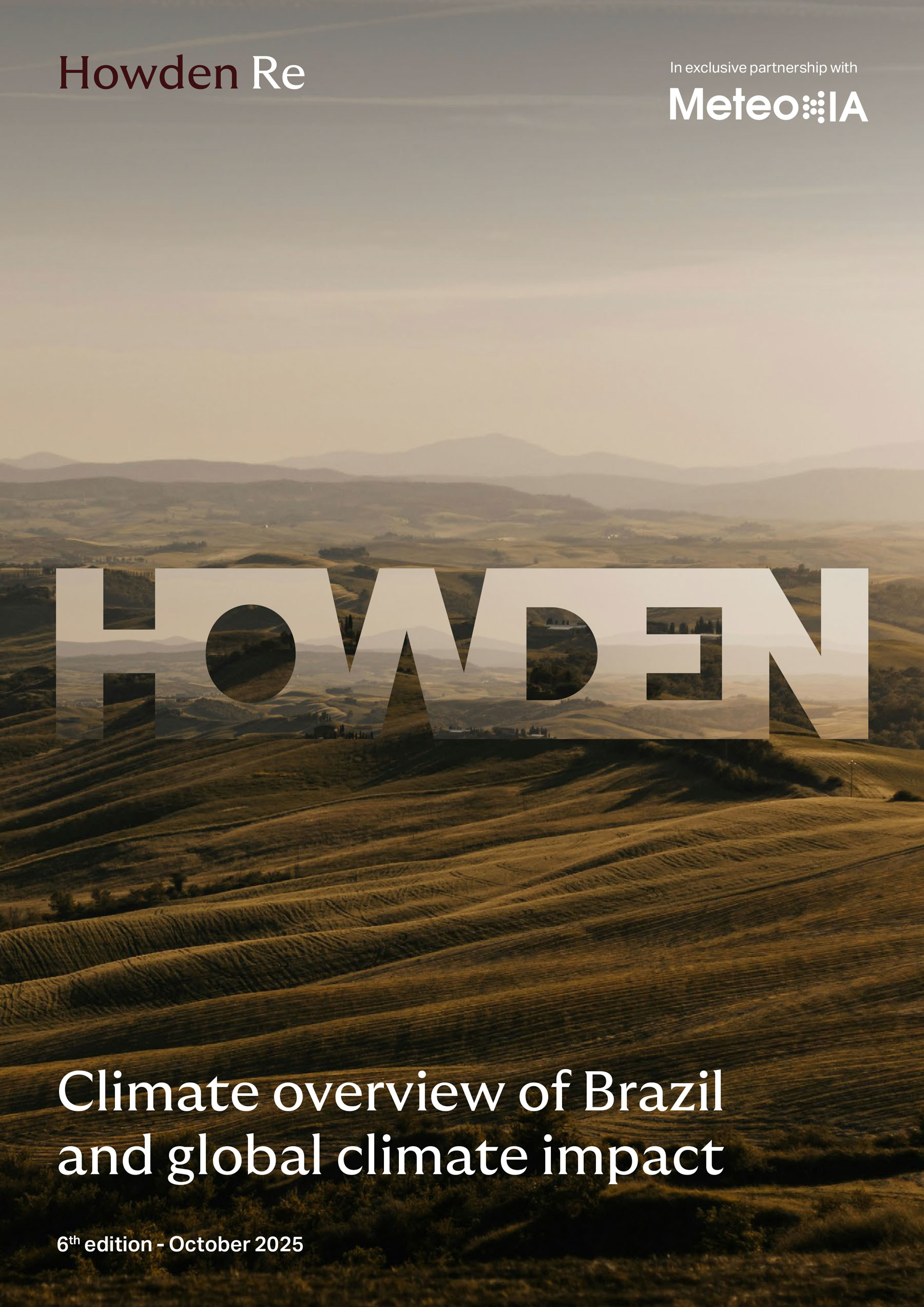Howden Re’s Sixth Brazil Climate Report tracks deepening variability and resilience ahead of COP30
Howden Re Brazil, in collaboration with MeteoIA, has released the sixth edition of its Brazil and Global Climate Impacts report, which provides an assessment of the country’s climate conditions from June to August 2025. This latest issue highlights a quarter defined by contrasting extremes: intense rainfall and reservoir recovery in the South, worsening drought in parts of the Northeast, and a series of disruptive cold waves and hailstorms that tested agricultural and energy resilience. This is against the backdrop of intensifying climate activity globally as COP30 in Belém, Brazil approaches.
As Brazil prepares to host COP30, this report reinforces the urgency of transforming data into action,” said Antônio Jorge da Mota Rodrigues, Head of Howden Re Brazil. “The climate system is no longer defined by linear patterns but by overlapping extremes. At Howden Re, we are committed to using analytics to help shape solutions that anticipate risk, support sustainable finance, and strengthen resilience across all sectors of society.
Climate variability continues: floods, frost, and heatwaves
From June to August 2025, Brazil experienced a wide range of extreme weather conditions.
- June: The MIA Climate model accurately forecast above-average rainfall in parts of the Southeast and Mato Grosso do Sul, confirmed by ERA5 data. In Rio Grande do Sul, recurrent frontal systems and extratropical cyclones produced heavy rain, with rivers again exceeding flood thresholds.
- July: Negative rainfall anomalies dominated the Centre-South, while the North remained wetter than average under the influence of the Intertropical Convergence Zone (ITCZ). During the same month, record sea storms and hail were reported across Minas Gerais, damaging hundreds of hectares of coffee plantations.
- August: Rainfall was near normal in most regions, although a strong cold front at the end of the month brought more than 200 millimetres of rain to parts of the South. Polar air masses caused frost across the highlands of Paraná, Santa Catarina, and Rio Grande do Sul, affecting winter crops and coffee production. Across the country, Civil Defence data recorded more than 12,000 people left homeless, 52,000 displaced, and 547 injured as a result of floods, landslides, and storms between June and mid-August.

Drought and hydrological shifts
The drought monitor for mid-2025 reveals a mixed national picture. Conditions improved in the South and Central-West following heavy rainfall in May, which restored rivers and reservoirs. However, drought conditions worsened in the Northeast, with extreme drought recorded in Bahia and Piauí and severe drought spreading across parts of São Paulo and Santa Catarina. By August, the southern reservoir subsystem had risen sharply from 33.5 per cent in May to 89.7 per cent, while storage levels in the Northeast fell to 59 per cent and the Southeast/Central-West subsystem remained around 57 per cent. This uneven recovery highlights the close interdependence between water, energy, and agriculture. The red tariff flag level 2 remained in effect through September as hydropower output continued to face demand pressure.
Spring 2025 outlook: low predictability amid transition
According to MeteoIA’s MIA Climate model, the coming months from September to November 2025 will be influenced by neutral El Niño–Southern Oscillation (ENSO) conditions, with about a 50 per cent chance of transition to a weak La Niña. A positive Antarctic Oscillation (AAO) and continued warming in the North Atlantic are also shaping the forecast.
Rainfall: Below-average precipitation is expected in the Centre-West, Southeast, Paraná, and parts of Pará in September. Wetter conditions are likely in October across Rio Grande do Sul, São Paulo, and Mato Grosso do Sul, followed by a drier pattern in November.
Temperature: Maximum and minimum temperatures are expected to remain slightly above average across most regions, particularly in the South later in the season. This may increase heat stress in crops and contribute to higher urban temperatures. The report notes that differences between AI-based and dynamic models, such as C3S–ECMWF, continue to create uncertainty for the start of the 2025–26 rainy season.
Agriculture: record yields despite weather stress
Brazil’s agricultural sector demonstrated resilience despite challenging conditions. The first corn crop reached 131.97 million tonnes, an increase of 14 per cent year-on-year, supported by productivity gains and improved planning. The second crop, or safrinha, achieved a record 109.57 million tonnes, with Mato Grosso do Sul reporting an all-time high of 14.2 million tonnes despite losses caused by wind and frost. MeteoIA’s composite risk mapping correctly identified high-risk zones in southern Paraná, Mato Grosso, and Mato Grosso do Sul, confirming early warnings about the combined effects of temperature extremes and strong winds. Looking ahead, the 2025–26 soya season is expected to see favourable growing conditions in Mato Grosso, Goiás, and Mato Grosso do Sul, while Minas Gerais and northern Maranhão may face increased risk due to inconsistent rainfall and high temperatures.